ODEX
Drill and case deep holes simultaneously in all types of formation
Download our brochure for full specifications
Overburden Drilling
As much as 90% of the land surface of the earth is covered with loose, unconsolidated material such as soil, clay, silt, sand, gravel, and boulders, which varies in depth from a few centimeters to hundreds of meters.
Drilling through this so-called overburden is often problematic, due to the tendency of the earth to cave in behind the drill bit. This makes it difficult to retrieve the drill string after the hole has been drilled. In practice, the bore hole is often lost before a casing tube can be inserted to support it.
Other problems are caused by cavities or porous ground, which interfere with the circulation of the flushing medium and prevent the drill cuttings from being flushed out of the hole.
In places where overburden strata are mixed, or when the ‘drillability’ is unknown, it is difficult for the driller to decide what tools to use to get the best overall results without risking the loss of equipment in the hole.
ODEX G2 equipment is designed to overcome such problems
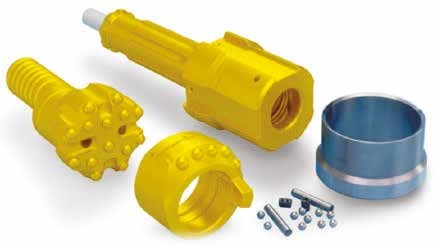
The ODEX Method
ODEX equipment enables you to drill and case deep holes simultaneously in all types of formation, even those with large boulders. Casing diameters from 114mm (ODEX 90) to 273 mm (ODEX 240) can be used – 90 and 240 in the ODEX code stands for pilot outer diameter.
The method is based on a pilot bit and eccentric reamer, which together drills a hole slightly larger than the external diameter of the casing tube. This enables the casing tube to follow the drill bit down the hole.
When using ODEX, part of the impact energy is diverted to the casing tube via a shoulder on the guide device, which in turn impacts a special casing shoe at the lower end of the casing.
In both DTH and top hammer drilling the casing is driven down into the hole without the pipe rotating. When the casing enters far enough into the bedrock, drilling is stopped briefly by lifting off bottom, with reverse rotation applied carefully, which causes the reamer to turn in, thus reducing the overall diameter of the drill bit assembly.
When this has been accomplished, the entire drill string can be pulled up through the inside of the casing tubes, leaving the latter embedded in the bedrock. Drilling can then be continued into the bedrock using a conventional drill string.
To improve flushing, the ODEX guide device has backward pointing flushing holes. In difficult conditions, a foaming additive can be added to the compressed air to further improve flushing performance.
Commercially available steel tubes in standard dimensions are used for the casing. They are welded together and left in the ground after the hole has been completed (ODEX W).
For applications where the casing is to be reused, it generally pays to use threaded casing tubes (ODEX-T).
Optimum utilization of any product is naturally dependent on correct handling. Service and training are therefore an important part of our product program. TerraRoc can offer complete training packages for operators and maintenance
personnel.
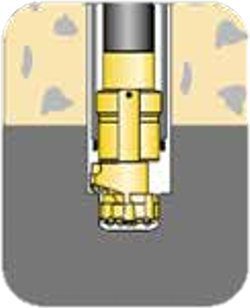
1. When drilling starts, the ODEX reamer swings out and reams the pilot-hole wide enough for the casing tube to slide down behind the drill bit assembly.
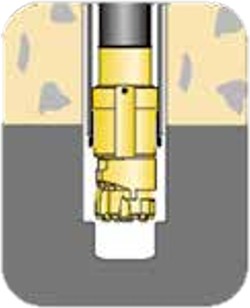
2. When the required depth is reached, rotation is reversed carefully, whereupon the reamer swings in, allowing the drill bit assembly to be pulled up through the casing.
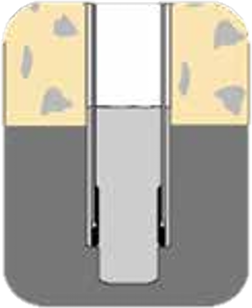
3. Casing tubes that are to be left in the drill hole should be sealed at the bottom of the hole by means of cement grout or some other sealing agent.
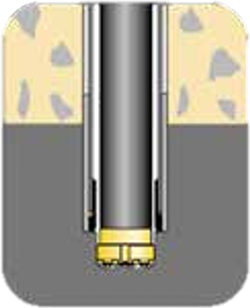
4. Drilling continues to the desired depth in the bedrock using a conventional drillstring.
ODEX G2 FOR DTH
Rock Drill Recommendations
All ODEX systems require drill rigs with independent, reversible rotation, with sufficient torque to match the hole diameter and depth requirements.
The following ODEX dimensions are available for down-the-hole drilling:
ODEX 90 for 3” hammers
ODEX 115 for 3” and 4” hammers
ODEX 140 for 4” and 5” hammers
ODEX 165 for 5” and 6” hammers
ODEX 190 for 6” and 8” hammers
ODEX 240 for 8” hammers
Guide devices are available to fit most common hammer shanks.
ODEX 90 and 115 for top hammers are characterized by using a guide device with impact shoulder that drives the casing via the casing shoe.
| ODEX for DTH | Recommended casing dimensions | |||||
|---|---|---|---|---|---|---|
| Shank | Drill pipes diameter | Pilot diameter | Reaming diameter | Weldable casing | Threaded casing | |
| ODEX 90 | DHD3.5 | 76 mm | 90 mm | 123 mm | Recommended diam- 114.2 mm (max-115 mm) Inner diam- min 102 mm Max wall thickness-6.5 mm | Outside diam = 114.3 mm Wall thickness = 6.3 mm Right-hand thread |
| ODEX 115 | QLX 40 TD40 Cop44G DHD 340 | 76 mm 89 mm | 115 mm | 152 mm | Recommended diam- 139,7 mm (max-142 mm) Inner diam- min 128 mm Max wall thickness-7 mm | Outside diam = 139,7 mm Wall thickness= 5,8 mm Right-hand thread |
| ODEX 140 | QL50 DHD 350 DHD340 QLX40 | 89 mm | 140 mm | 181 mm | Recommended diam- 168,3 mm (max-171 mm) Inner diam- min 157 mm Max wall thickness-7 mm | Outside diam = 168,3 mm Wall thickness= 6,3 mm Right-hand thread |
| ODEX 165 | QL60 DHD 360 DHD 350 QL 50 | 114 mm | 165 mm | 209 mm | Recommended diam- 193,7 mm (max-196 mm) Inner diam- min 183 mm Max wall thickness-6,5 mm | Outside diam = 193,7 mm Wall thickness= 6,3 mm Right-hand thread |
| ODEX 190 | QL60 DHD 360 | 114 mm | 190 mm | 237 mm | Recommended diam- 219,0 mm (max-222 mm) Inner diam- min 205 mm Max wall thickness-8,5 mm | Threaded casings not available for this size |
| ODEX 240 | QL80 DHD 380 | 114 mm | 240 mm | 306.5 mm | Recommended diam- 273,0 mm (max-280 mm) Inner diam- min 260 mm Max wall thickness-10 mm | Threaded casings not available for this size |
